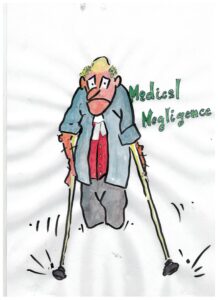Time to tart-up one’s Pleadings?
- 2017-12-06
- By whiggs
- Posted in Civil Liability Act, common law, Personal Injury, Pleading
Is this the new normal when pleading claims under the MACA/Civil Liability Act?
From Fairall v Hobbs [2017] NSWCA 82; 347 ALR 151
- A fundamental problem in the way the respondent (the plaintiff below) and the primary judge approached the issue of the existence and scope of the duty of care in this case is that each failed to address the requirements of s 5B of the Civil Liability Act which applied to the MACA in this case: s 3B(2) Civil Liability Act.
- In Adeels Palace Pty Ltd v Moubarak (2009) 239 CLR 420; [2009] HCA 48 at [11] it was emphasised by the plurality that it was of the “first importance” to identify the proper starting point, which, both in that appeal and here, was the Civil Liability Act, without which there was a “serious risk that the inquiries about duty, breach and causation will miscarry”.
- As Meagher JA said in Garzo v Liverpool / Campbelltown Christian School. [2012] NSWCA 151 at [22]:
“To address the questions and considerations in s 5B, it is necessary to formulate a plaintiff’s claim in a way which takes account of the precautions which it is alleged should have been taken and identifies the risk or risks of harm which the plaintiff alleges eventuated and to which those precautions should have been directed.”
- What was required in this case was that the primary judge should clearly identify the risk (or risks) of harm in respect of which the second defendant below was obliged to take precautions. It is against that risk of harm that the court would then have been in a position to determine the second defendant’s knowledge of a specified risk of harm, to assess the probability of that risk occurring, and to evaluate the reasonableness of the second defendant’s response, or lack of response, to that risk: see RTA v Dederer (2007) 234 CLR 330; [2007] HCA 42 at [59]-[61] per Gummow J.
- The need to identify the “risk of harm”, and to satisfy each of the requirements in s 5B, has been emphasised in numerous subsequent cases in this Court: Shoalhaven City Council v Pender [2013] NSWCA 210 at [55]-[72] and [83] ff; Reid v Commercial Club (Albury) Ltd [2014] NSWCA 98 at [139]-[160]; and Uniting Church in Australia Property Trust (NSW) v Miller; Miller v Lithgow City Council(2015) 91 NSWLR 752; [2015] NSWCA 320 at [100]-[129].
- The failure by the primary judge to identify the relevant risk of harm means grounds 9-11 of the notice of appeal should succeed. The failure to identify the risk (or risks of harm) left the court below in no position to determine the second appellant’s knowledge of a specified risk of harm, to assess the probability of that risk occurring, and to evaluate the reasonableness of the second appellant’s response, or lack of response, to that risk or those risks. The steps taken or not taken by the second appellant relating to the speed and proximity of the vehicle to the respondent and his horse could not be tested in this case, as they must, against a properly identified risk of harm. It was of no assistance to reason that the second appellant failed in her duty by moving her car two or three metres from the kerb, as that was “insufficient”. It is relevant to observe “insufficient” when compared to what standard? The primary judge’s reasoning, by omitting a properly identified risk of harm against which to test the second appellant’s conduct, begs the question relevant question.
- It was also no answer to the failure properly to identify the duty of care and the relevant risk of harm to point to evidence of the second appellant “seeking to exculpate herself” or evidence said to constitute an admission by the second appellant that to drive past a horse safely she should drop her speed to somewhere below the speed limit. At best that evidence could have gone to the question of the second appellant’s knowledge of a specified risk of harm. Having failed to identify any risk of harm, as his Honour was required to do, the primary judge fell into error.
SEARCH BLOG POSTS
LATEST BLOG POSTS
- Updated product safety mandatory reporting guidance for suppliers now available
- Pleading fraud – cause and effect is essential
- Does the Trustee’s right of indemnity have priority over the right of beneficiaries in relation to assets?
- Rules of war (in a nutshell) | The Laws Of War
- MH370 Final Report
Past Blog Posts
- December 2021
- September 2021
- August 2021
- May 2021
- April 2021
- March 2021
- August 2020
- February 2020
- September 2019
- February 2019
- December 2018
- July 2018
- April 2018
- December 2017
- May 2017
- February 2017
- December 2016
- November 2016
- October 2016
- September 2016
- August 2016
- April 2016
- March 2016
- October 2015
- September 2015
- August 2015
- May 2014
- April 2014
- March 2014
- January 2014
Categories
- Appeals
- Artificial Intelligence
- Aviation law
- Banking and Finance Law
- Blogs
- Civil Liability Act
- Class Actions
- Coding for lawyers
- common law
- Consumer Claims (TPA)
- Contract Law
- Contractual Interpretation
- Criminal law
- Deeds
- Docassemble
- duty of care
- Engineering Law
- Equity
- Evidence
- Exclusion Clauses
- Execution of documents
- Expert Witness
- featured
- Financial Services
- Fraud
- Fundraising (Chapter 6D)
- General comment
- Home Building Law
- Insurance
- Legal drafting
- Local Court
- Medical Negligence
- MH370
- Motor Accidents
- Negligence
- Occupiers negligence
- Other
- Personal Injury
- Personal Property Securities (PPSA)
- Pleading
- Practice & Procedure
- Products Liability
- Property
- Real Property
- Reasons for a decision
- Securitisation
- Security (Mortgages & Charges)
- Sentencing
- Swaps & Derivatives
- Teaching
- Transactional Law
- Transfer of financial assets in transactions
- Trusts & Trustee Law
- Uncategorized
- War and Weaponry
- Witnesses
SEARCH BLOG POSTS
LATEST BLOG POSTS
- Updated product safety mandatory reporting guidance for suppliers now available
- Pleading fraud – cause and effect is essential
- Does the Trustee’s right of indemnity have priority over the right of beneficiaries in relation to assets?
- Rules of war (in a nutshell) | The Laws Of War
- MH370 Final Report
Past Blog Posts
- December 2021
- September 2021
- August 2021
- May 2021
- April 2021
- March 2021
- August 2020
- February 2020
- September 2019
- February 2019
- December 2018
- July 2018
- April 2018
- December 2017
- May 2017
- February 2017
- December 2016
- November 2016
- October 2016
- September 2016
- August 2016
- April 2016
- March 2016
- October 2015
- September 2015
- August 2015
- May 2014
- April 2014
- March 2014
- January 2014
Categories
- Appeals
- Artificial Intelligence
- Aviation law
- Banking and Finance Law
- Blogs
- Civil Liability Act
- Class Actions
- Coding for lawyers
- common law
- Consumer Claims (TPA)
- Contract Law
- Contractual Interpretation
- Criminal law
- Deeds
- Docassemble
- duty of care
- Engineering Law
- Equity
- Evidence
- Exclusion Clauses
- Execution of documents
- Expert Witness
- featured
- Financial Services
- Fraud
- Fundraising (Chapter 6D)
- General comment
- Home Building Law
- Insurance
- Legal drafting
- Local Court
- Medical Negligence
- MH370
- Motor Accidents
- Negligence
- Occupiers negligence
- Other
- Personal Injury
- Personal Property Securities (PPSA)
- Pleading
- Practice & Procedure
- Products Liability
- Property
- Real Property
- Reasons for a decision
- Securitisation
- Security (Mortgages & Charges)
- Sentencing
- Swaps & Derivatives
- Teaching
- Transactional Law
- Transfer of financial assets in transactions
- Trusts & Trustee Law
- Uncategorized
- War and Weaponry
- Witnesses




